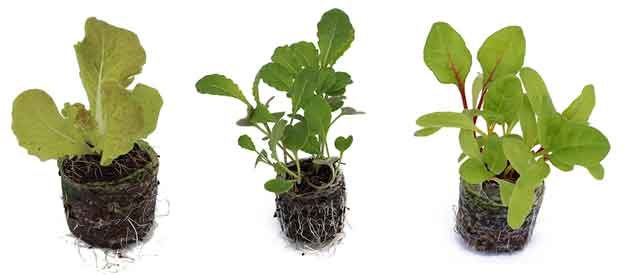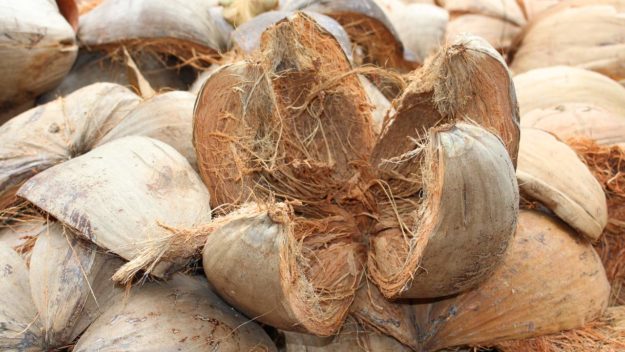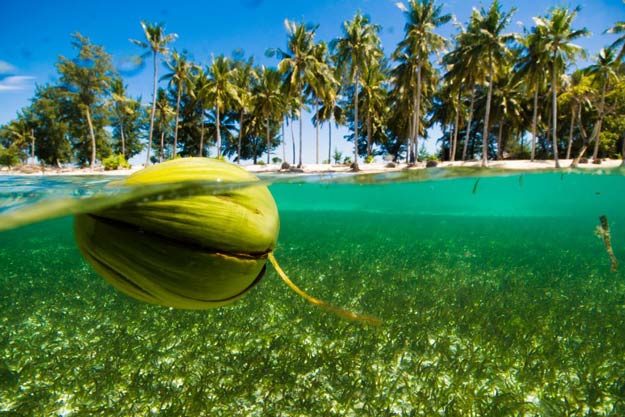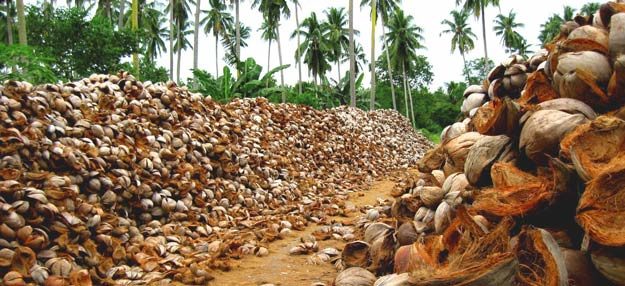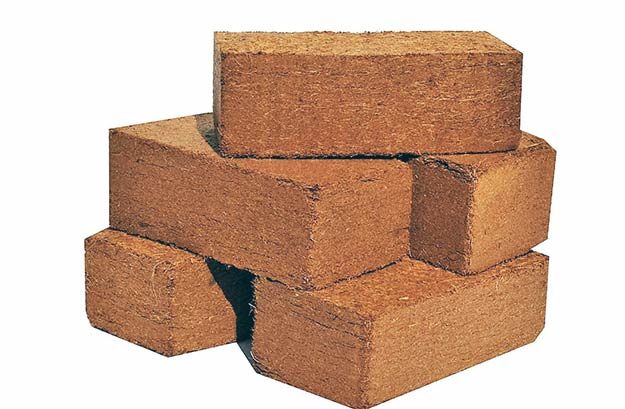Growing seedlings in soil from your own garden involves serious preparation and modification of that very soil. Nowadays, one can choose an alternative to garden soil, and quite a few options exist. One such option is coconut substrate.
Microgreens in Jiffy tablets made from coconut coir.
I want to try growing my first seedlings in coconut substrate (CS) and have reviewed scientific research on the topic. I am sharing my conclusions with you here.
To answer the question posed in the article’s title right away: yes, coconut substrate for seedlings is a good choice. I’ll attempt to review all the nuances here, and as usual, the list of references is provided at the end of the article.
What is Coconut Substrate?
It is a specially processed coir that covers the shells of coconuts. The coconuts you see on supermarket shelves are already peeled so we don’t get the pleasure of experiencing it in its raw form.
Due to the specific way coconut palms reproduce, coir has evolved into a durable, highly porous fiber resistant to degradation in saltwater, rotting, and fungal colonization for several years.
Coconut migration.
The durability of coir against nearly everything is made possible by its high lignin content—a mixture of compounds resulting from the transformation of woody plant cells.
Not every microorganism can consume lignin, and for the vast majority of microbiological pests, coconut substrate is not a friendly environment for colonization. That said, it is not sterile! (6) Fungal spores and bacteria easily settle on the fibers during processing, packaging, transportation, and storage and can wait a long time for favorable conditions to affect your seedlings. Do not neglect treatment with biological products.
The production of coconut coir is a labor-intensive, lengthy process often involving manual labor. It includes months of soaking, anaerobic bacterial fermentation, steaming, and pressing. Greenhouse farms worldwide strongly incentivize the production of coconut substrates, leading to the development of efficient biotechnological methods for processing coir. For instance, fermentation involving special enzymes that accelerate the preparation of the fiber to just a few days, allowing it to be soaked in fresh water (I’ll explain below why this is important).
Here’s a visual video showing the processing of coconut fibers:
Drying the future substrate resembles roasting coffee beans but at lower temperatures with strong airflow. Coconut blocks are formed using hydraulic presses.
Coconut raw material is one of the major industrial drivers for Sri Lanka, supporting a large workforce. Previously, coconut shells rotted in landfills by the thousands of tons (annual production of 12,000,000 tons, Nichols, 2013). Now, it serves as an excellent and inexpensive material for hydroponics, greenhouses, high-quality mattress production, geotextile mats, rugs, and many other eco-friendly products.
Waste dump from production.
I like the idea of utilizing such material, so I want to explore its features and assess whether coconut substrate is suitable for growing seedlings.
Coconut Soil from an Agro-Biological Perspective
CS has been extensively studied. All its properties relevant for growing seedlings are described below.
Physical, Chemical, and Biological Properties of Coconut Substrate
For clarity, I’ve compared it with the characteristics of sphagnum peat moss.
| Particle Size, mm | Total Porosity, % | Air Content, % | Rewetting Capability | Surface Porosity, % | Water Retention Potential, ml/L | pH | Free Water, % | |
| Coconut Substrate | 0.79 | 94 | 32 | up to 5 times | 41 | 786 | 6.1-7.1 | 35 |
| Peat | 1.73 | 66 | 1 time | 12 | 620 | 2.6-3.8 | 22.5 |
Elemental Composition of Coconut Substrate
| Coconut Coir | Peat | |
| Carbon % | up to 49 | up to 65 |
| Nitrogen mg/kg−1 | 44 | 64 |
| Phosphorus mg/kg−1 | 38 | 42 |
| Potassium mg/kg−1 | 1560 | 246 |
| Calcium mg/kg−1 | 58 | 1668 |
| Magnesium mg/kg−1 | 55 | 636 |
| Sulfur | 405 | 645 |
| Lignin % | 46 | 1.8-22 |
| Cellulose % | 43 | up to 15 |
Relatively high elasticity, resistance to compression, and minimal volume loss over time compared to other organic media like peat and bark (Wever and van Leeuwen, 1995; Argo and Biernbaum, 1996). Biomass increase on coconut coir surpasses that on peat and mineral wool (2).
Compared to mineral wool (MW) and peat, cultivation on coconut coir demonstrates the highest nutrient absorption by crops, especially sulfur, potassium, and phosphorus. All photosynthesis-related parameters (photosynthesis rate (Pn), stomatal conductance (Gs), intercellular CO2 concentration (Ci), and evaporation rate (E)) were significantly higher with coconut substrates (2). The same applies to fruit mass — in the aforementioned study, tomatoes were grown, and the increased potassium content in coir positively influenced the future yield. Although potassium is an antagonist of calcium and magnesium, plants did not exhibit deficiencies in these elements.
It is important to remember that calcium deficiency always accompanies soilless substrates. This element is especially important for tomato immunity.
Coconut substrates improve root formation and stimulate root growth due to hydroxybenzoic acids formed during the fiber fermentation process (Suzuki et al., 1998).
With rare exceptions, coconut coir is not produced specifically for horticulture, so its properties can vary greatly. An important factor is the increased content of sodium, potassium, and chlorine salts in the fiber. Before preparing the mix, it is ESSENTIAL to rinse the substrate multiple times and treat it with calcium nitrate+magnesium sulfate. You can rinse coconut substrate according to instructions on the Floragrowing website and learn more about substrate stabilization on the DragiGrow blog. There is a chance you might purchase already prepared cocopeat, indicated by its higher cost compared to alternatives and specific labeling on the packaging. Buffered substrate cannot be cheap.
Field Studies
Cultivation of crops on coconut substrate often yields contradictory results. Soil substitutes have different effects on different varieties of the same species — the same substrate works differently depending on the variety grown on it. Traditional, less energetic “old-school” varieties are much more sensitive to the substrate than modern hybrids. Commercial varieties and hybrids generally show no notable differences when grown on peat, vermicompost, or coconut coir.
All studies are conducted using pure substrates, without rinsing, buffering, or adding necessary fertilizers (unless otherwise specified). Therefore, it is impossible to claim that peat is good and coconut is bad — proper soil preparation and timely supplementation are key to avoiding disappointment, even with mineral wool.
An important observation about irrigating coconut substrates was made in a Spanish study (5). Excessive drainage can dehydrate the soil and force seedling roots to grow more, weakening the plant’s aerial parts. Coconut substrates retain 10-15% less water than peat+vermicompost. There is a likelihood that coconut coir binds nitrogen, depriving plants of it.
Another issue arises from the main advantage of coconut substrate — oxidative stress due to high aeration. The accumulation of reactive oxygen species in chloroplasts and mitochondria leads to leaf paling and selective permeability of cell membranes (lower immunity). Plants combat oxygen by producing special enzymes like peroxidases, which is energetically costly. Too much air can be as damaging as too little.
Pros and Cons of Coconut Substrates
Coconut substrates have their peculiarities, which cannot be unequivocally categorized as advantages or disadvantages.
- Coir delivers excellent results for seedlings, but only with proper substrate preparation (discussed above) and precisely managed nutrient and biopreparant application. The advantage is that the substrate is fully controllable, with tailored nutrition standards for each plant type. The downside is the need for self-education and time to master this system.
- Root system development: good balance of drainage, water retention, and aeration. However, there is a risk of oxidative stress.
- Its neutral pH level eliminates the need for a soil preparation step — alkalization. Instead, you should monitor the acidity of irrigation water and applied fertilizers.
- Minimal pest contamination risk. The physicochemical characteristics of coir minimize colonization by pathogenic microorganisms and fungi. Microflora must be introduced manually (Bacillus subtilis, Metarhizium, Trichoderma, nitrogen fixers). This is a commonly accepted opinion, though some studies report a high fungal and bacterial background in coconut substrates (6).
- Can be reused for several seasons by simply drying and re-wetting, without re-buffering.
- High sodium and potassium salt content is unacceptable for growing plants in an unprepared “off-the-shelf” substrate.
- Risk of immobilizing calcium, magnesium, and iron, which can be avoided by properly preparing the mixture. Growers of a certain well-known banned plant are familiar with nutrient deficiencies. Special mineral mixes have been developed for them, which adequately meet the needs of coconut substrates, taking into account the increased cation exchange, changes in pH, and the retention of Ca, Mg, and Fe.
- More frequent watering and constant moisture control are required. It is almost impossible to overwater plants in a coconut substrate, which can be an undeniable plus for small planting volumes.
- High-quality coconut blocks, prepared by the manufacturer with freshwater and buffering, are unjustifiably expensive for hobby gardening.
- Coir that has not undergone complete fermentation significantly holds back nitrogen. It may be possible to add nitrogen-fixing bio-preparations to the soil to help return nitrogen to the plants(?).
- Settles over time, slightly more than peat but much less than garden soil.
Which type of coconut soil should you use for seedlings?
For gardening and floriculture, several types of substrates are produced, differing in composition and fraction: in the form of peat, chips, and fiber. Peat is compressed “dust” that settles when the fiber is sieved. It is specifically this “dust” that is pressed into coco blocks with the addition of coarser fractions and a small amount of fiber. This type of soil is well-suited for seedlings since it mimics natural soil with particles of different fractions.
Chips, peat, and fiber
Coconut chips and fibers are good for mulching.
Coconut blocks, each kilogram of which can expand into 6-7 liters of loosened substrate
How to improve coconut substrate?
Prepare mixtures based on coir by adding perlite, vermiculite, biohumus, vermicompost, sterilized garden soil, and peat. As for fertilizers, there is no universal formula, except for the mandatory buffering with Ca+Mg and the addition of iron.
Remember, compost increases the acidity of the potting mix!
Unfortunately, I’ll have to prepare the mixture “by eye” since I don’t have an EC meter to measure electrical conductivity, so I can’t conduct a proper masterclass. There’s a video on YouTube showing the complete preparation of coco-soil by a grower—look it up.
I’ll share my results in May if I manage to grow anything.
Update 10/22/20: I managed to grow my seedlings in coco, but without a control group. Considering my complete lack of experience, it turned out relatively well—none of the sprouts got sick. My main mistakes were using small containers and choosing the wrong type of container—non-woven fabric cups. I strongly do not recommend them. I’ll prepare separate material on this topic. I won’t use pure coconut substrate again but as a soil improver, it’s irreplaceable. With peat, coconut, and perlite + 50% garden soil, you can create a nearly ideal potting mix .
Literature
Materials are available on Google Drive
- Physical Properties of Various Coconut Coir Dusts Compared to Peat HORTSCIENCE 40(7):2138–2144. 2005.
- Comparison of Coconut Coir, Rockwool, and Peat Cultivations for Tomato Production: Nutrient Balance, Plant Growth, and Fruit Quality Front. Plant Sci., 02 August 2017.
- Substrates and their analysis.
- Quantifying Differences between Treated and Untreated Coir Substrate Organic Matter Management and Compost in Horticulture Acta Hort. 1018, ISHS 2014.
- Effect of different substrates for organic agriculture in seedling development of traditional species of Solanaceae.
- Physical, Chemical, and Biological Properties of Coir Dust, 1997.
